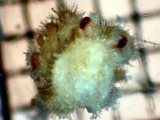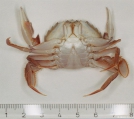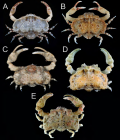Decanet taxon details
Alox naispela Galil & Ng, 2015
1036032 (urn:lsid:marinespecies.org:taxname:1036032)
accepted
Species
marine, brackish, fresh, terrestrial
recent only
Galil, B. S.; Ng, P. K. L. (2015). Leucosiid crabs from Papua New Guinea, with descriptions of eight new species (Crustacea: Decapoda: Brachyura). <em>Zootaxa.</em> 4027(4): 451-486., available online at https://doi.org/10.11646/zootaxa.4027.4.1 [details] Available for editors 
Type locality contained in Papua New Guinean Exclusive Economic Zone
, Note Holotype: 1 ovigerous female (8.3 mm)...
05°05.3'S 145°48.1'E, 1–6 m, 17.12.2012. Paratypes: 1 immature female (6.3 mm) (MNHN-IU-2013-1193), stn
PD66, south Yabob I., 05°15.5'S 145°47.3'E, 2–6 m, 3.12.2012; 1 immature female (6.6 mm) (ZRC 2015.269), stn
PD73, Madang, 6.12.2013. [details]
type locality contained in Papua New Guinean Exclusive Economic Zone [details]
From editor or global species database
Type material Holotype: 1 ovigerous female (8.3 mm) (MNHN-IU-2013-1352), stn PD31, Alexishafen,05°05.3'S 145°48.1'E, 1–6 m, 17.12.2012. Paratypes: 1 immature female (6.3 mm) (MNHN-IU-2013-1193), stn
PD66, south Yabob I., 05°15.5'S 145°47.3'E, 2–6 m, 3.12.2012; 1 immature female (6.6 mm) (ZRC 2015.269), stn
PD73, Madang, 6.12.2013. [details]
Etymology From naispela for “beautiful” in Tok Pisin, the Pidgin language spoken in Papua New Guinea. Used as a noun in apposition.
Etymology From naispela for “beautiful” in Tok Pisin, the Pidgin language spoken in Papua New Guinea. Used as a noun in apposition. [details]
DecaNet eds. (2025). DecaNet. Alox naispela Galil & Ng, 2015. Accessed at: https://decanet.info/aphia.php?p=taxdetails&id=1036032 on 2025-09-13
Date
action
by
original description
Galil, B. S.; Ng, P. K. L. (2015). Leucosiid crabs from Papua New Guinea, with descriptions of eight new species (Crustacea: Decapoda: Brachyura). <em>Zootaxa.</em> 4027(4): 451-486., available online at https://doi.org/10.11646/zootaxa.4027.4.1 [details] Available for editors 
 Present
Present  Inaccurate
Inaccurate  Introduced: alien
Introduced: alien  Containing type locality
Containing type locality
From editor or global species database
Etymology From naispela for “beautiful” in Tok Pisin, the Pidgin language spoken in Papua New Guinea. Used as a noun in apposition. [details]Type material Holotype: 1 ovigerous female (8.3 mm) (MNHN-IU-2013-1352), stn PD31, Alexishafen,
05°05.3'S 145°48.1'E, 1–6 m, 17.12.2012. Paratypes: 1 immature female (6.3 mm) (MNHN-IU-2013-1193), stn
PD66, south Yabob I., 05°15.5'S 145°47.3'E, 2–6 m, 3.12.2012; 1 immature female (6.6 mm) (ZRC 2015.269), stn
PD73, Madang, 6.12.2013. [details]




